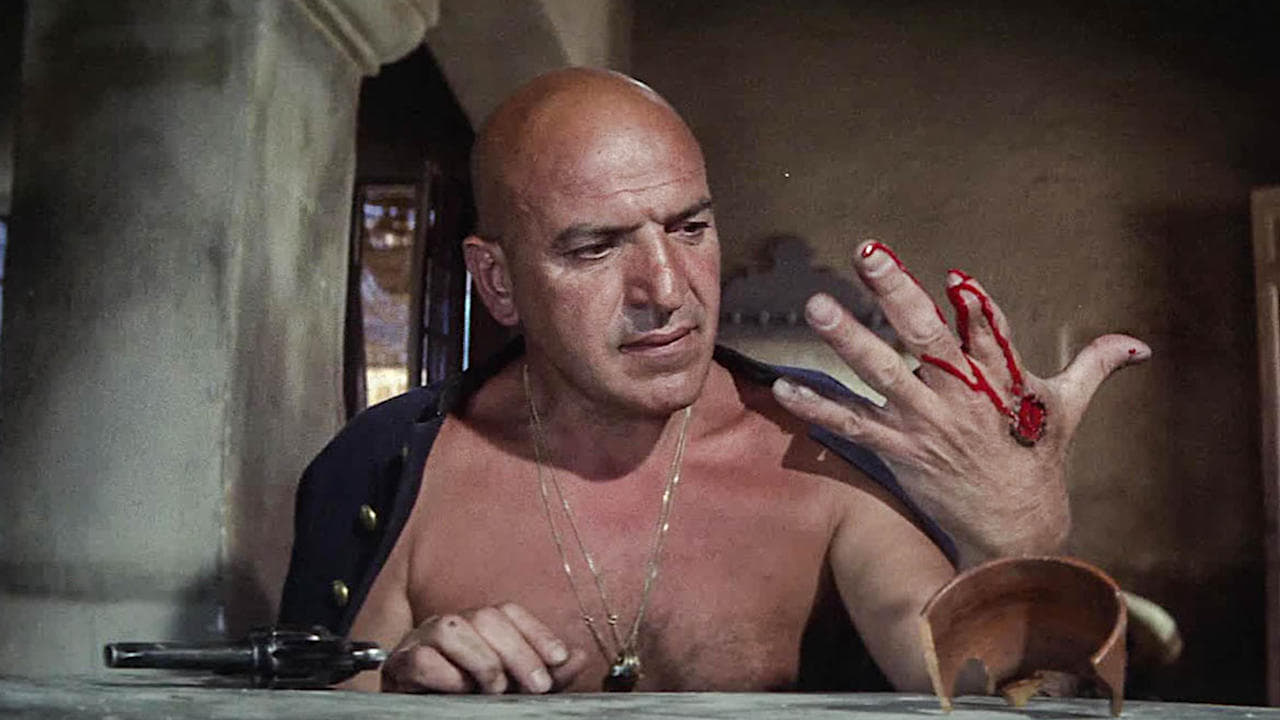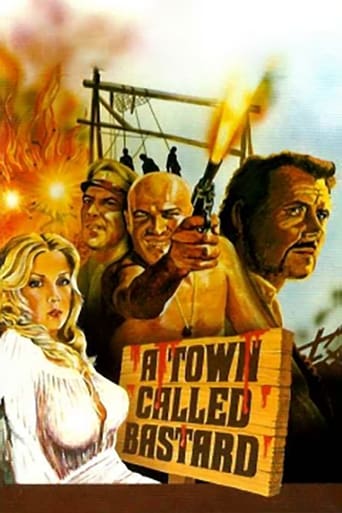



Very very predictable, including the post credit scene !!!
View MoreI have absolutely never seen anything like this movie before. You have to see this movie.
View MoreThe movie's not perfect, but it sticks the landing of its message. It was engaging - thrilling at times - and I personally thought it was a great time.
View MoreOne of the best movies of the year! Incredible from the beginning to the end.
View MoreNot quite sure yet about A TOWN CALLED BASTARD as the widescreen version from Greece I saw was titled. It sure is something else, one of the most brutal, vicious, mean spirited films to come out of the Spaghetti Western years. A British and Spanish co-production, the film took the form of the languid, surrealist Italo Western and corrupted it into something else. The only film I can equate it with would be THE DESERTER, a similar British-Spanish co-production from the early 1970s that likewise is one of the most vicious and bloodthirsty Westerns ever made.I quickly lost track of the story: Telly Savalas plays some sort of crazed Cossack Mexican officer who drifts into a small border town, takes it hostage and proceeds to kill just about everyone, usually by hanging. They don't just hang the people however, first they are adequately (and often perversely humorously) humiliated, then swung out on a rope overhead from a massive scaffold that would have been right at home in a Hammer Horror Frankenstein movie. The hangings aren't just dramatic, they are staged with a flourish that is beyond theatrical to the point of absurdity. The chilling, disturbing crowd reactions of the captives below forced to watch become far more potent after a while.And speaking of horror movies the film has a decidedly strange, gloomy bent to it that has far more in common with a Spanish horror tragedy than any comic book Spaghetti Western with guys shooting their hats off. The film specializes in the Quick Cold Killing, where both supporting and lead cast members are dispatched with sudden cruelty and often without a seeming purpose. Other than piling the bodies up, which at the end of the film stretch across the screen with smashed rubble, burning debris and the survivors wandering around in a daze.There's some decent talent involved however. Robert Shaw steals every scene he's in as a principled gun runner turned priest, Martin Landau as a conflicted Mexican officer who's zeal for killing is a fragile mask of sanity, Stella Stevens as the woman with the past to whom they are all connected, and the great 70s character actor Al Lettieri, buried under makeup to the point that I wasn't quite sure what part he was playing. Plus a smattering of the great Euro genre film actors: Aldo Sambrell, Georges Rigaud, Charley Bravo, Chris Huerta, and Waldo de los Ríos provides the bizarre musical score that manages to incorporate Johnny Horton singing "Battle Of New Orleans" which likely resulted in a soundtrack rights issue that has kept the film more or less out of print in North America. But its a great song and the film's sole light hearted moment.And that's the thing. As the guy who I watched it with summed things up best, what would have been the audience for this film? Which is a question I also asked myself after suffering through THE DESERTER. Here is a film that is simply too vicious and cruel to be enjoyed as a time killer shoot-em-up, let alone watched by a general audience. It has more in common with the adults oriented cynical disillusioned 1970s American westerns like SOLDIER BLUE, who's commercial success likely inspired the producers to decide on making a sick, ultra-violent Western with a body count in the thousands.Something was lost at the production stage, however, and the film's story is too oblique to resonate beyond the on screen carnage. There might be a pretty interesting Zapata style Mexican Revolution Spaghetti here at its core, with lots of requisition flashbacks + larger than life grudges held by larger than life characters. The film also serves as an interesting counterpoint to the "Trinity" inspired comedy Spaghetti Westerns that dominated the industry after 1970. Its well made, has a perverse sense of macabre humor, and its always great to see Martin Landau & Robert Shaw, two of my favorite actors. Plus nobody ever said a Western had to be a fun, uplifting party movie. Its just that sometimes it helps.5/10
View MoreIf the movie leaves you somewhat confused the first time around, you might try fast forwarding through it a second time like I did to pick up the pieces. That might clear up a a thing or two, but you'll still have to put up with some of the unresolved issues the flick has to offer. Most notable of these is the fate of Telly Savalas' character Don Carlos. In keeping with the erstwhile religious backdrop of the story, Don Carlos is crucified and left hung out to dry after being shot by one of his own henchmen. But what ever became of him - did he die? Interestingly, Savalas' entire screen time in the first half of the movie was played shirtless, but it did look pretty hot out there.There's a great scene of Stella Stevens in one of the Priest's (Robert Shaw) dream-scape recollections, that of an angel of death bearing a dagger. It's too bad nothing ever came of that tidbit. Alvira (Stevens) arrives in town seeking the one who murdered her husband, tricked out as a coffin sleeping vampire wannabe. But again, the astonishing symbolism is allowed to fritter away to nothing, even after someone offers - "Now do we kill the witch girl?"One thing for sure, the movie never goes where you think it might. Martin Landau appears as a Colonel on the trail of the mysterious revolutionary Aguila/the Eagle, and with the help of a blind man, identifies Robert Shaw's Priest as the one who killed the man in the Montes grave. The Priest concocts a story for Alvira Montes that he helped her husband kill himself so his name would live on as a martyr for their revolutionary cause. I say concocts, because if you study the flashback scene with the young and hairless faced Shaw, a man who looks like Alvira's husband in a picture shown earlier simply dies from bullet wounds, and quite unceremoniously at that. I'm open to other interpretations however.If the picture wasn't surreal enough, you'll find yourself going 'huh?' right as it breaks into a party scene to the tune of "The Battle of New Orleans". It's not Johnny Horton's voice, and it's got additional lyrics compared to the commercial version. Dropped in where it is makes it seem like a mid film intermission.But hey, if you're not in too serious of a mood, you might have some fun with this one, even as it teeters precariously on the traditional spaghetti Western fence. I can say this at least with some certainty, it's the only movie I've EVER seen where a character picks his nose on screen (a Mexican near the beginning of the film). The title of the movie would probably have been better served up as one of Clint Eastwood's spaghetti classics, but "High Plains Drifter" sounds a whole lot cooler.
View MoreThis British-Spanish co-production is one of the countless films shot in Spain in the wake of the unexpected phenomenal success enjoyed by the Italian "Spaghetti" Westerns and, as is typical of such genre efforts, features an eclectic assortment of established and emerging international stars: Robert Shaw, Telly Savalas, Stella Stevens, Martin Landau, Fernando Rey, Michael Craig, Al Lettieri, Dudley Sutton, Antonio Mayans, etc. Ironically, however, this incoherent mess of a movie serves as a shining example as to why that most American of film genres became a dying breed in the 1970s and is nowadays practically (or is that officially?) extinct.I really wanted to like this film, not only because the Western is one of my favorite types of movies but also because it had all the qualities, including an intriguing premise, to be a good one - not to mention the fact that my father had purchased a paperback edition of A TOWN CALLED BASTARD's novelization following its original release! As it is, the film's sole virtue (if, indeed, it can even be called that) is its sheer eccentricity: for instance, Stevens, playing a widow out for revenge on the man who betrayed her revolutionary husband, sleeps inside a coffin(!) driven around in a carriage by her dumb manservant(?) Sutton; Savalas, as a blood-thirsty renegade, who at first appears to be the film's main villain, is unceremoniously dispatched by his own henchman Lettieri very early on in the picture; the villain of the piece, then, turns out to be Landau who, in the film's very first scene, is seen pillaging side-by-side our legendary hero-turned-priest Shaw!; Fernando Rey, playing a blind peasant, is the only one who can identify rebel Shaw who, in the end turns out to have been merely a front for...well, nevermind! As you can see, the plot is very confusing and it gets stranger from there! The production team responsible for this film were also behind other Western fare around the same period of time, like CUSTER OF THE WEST (1967), BAD MAN'S RIVER (1971), CAPTAIN APACHE (1971) and PANCHO VILLA (1972).
View MoreWhen I see a late night film with 'bastard' in the title, I'm inclined to tape it and find out what it's about. (I've taped this twice and lost both, found it on DVD, seem to have lost that too). Yes it was listed as "A Town Called Bastard" by the BBC.If you're one of those people who think a good Western needs Mexicans (e.g. The Wild Bunch) this has plenty: sombreros, moustaches, guns, tortilla-preparation, cruel laughter etc. A lot of these Mexicans die, perhaps somewhat gratuitously. So if you like guns and death in sunny Mexico, and you'd like to see Telly Savalas as the Mayor of a town called Bastardo - you'll love this.e.g. "Who killed my husband?" demands the pale blonde: cue an old woman to shout the name from a high building - gun out, excellent shot (like shooting ducks at a fairground), another one bites the hot dry dust...The rest has already been well covered by other user comments, worth watching if this is your sort of thing.
View More